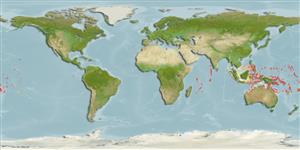Classification / Names
Common names from other countries
Main reference
Size / Weight / Age
Max length : 35.0 cm TL male/unsexed; (Ref. 30874)
Length at first maturity
Lm ?, range 19 - ? cm
Environment
Marine; reef-associated; depth range 0 - 30 m (Ref. 9710)
Climate / Range
Tropical, preferred ?; 12°N - 24°S, 55°E - 154°W (Ref. 5222)
Distribution
Indo-West-Pacific: East coast of Africa to the Line Islands. Except for its occurrence along the African coast (Zanzibar, Tanzania to Ponta Zavora, Mozambique) it seems to be primarily an insular species, occurring at most (probably all) of the islands of tropical Indian and west-central Pacific. Not known from the Red Sea, Persian Gulf, Sri Lanka, Philippines, Taiwan, Japan, or Australian waters (however, it is found at Rowley Shoals off Western Australia).
Countries | FAO areas | Ecosystems | Occurrences | Introductions
Short description
Dorsal
spines
(total): 11;
Dorsal
soft rays
(total): 14-16;
Anal
spines: 3;
Anal
soft rays: 8. Preopercle rounded, with a shallow notch; the serrae are enlarged but covered with skin; upper edge of the operculum almost straight. The head and body mostly covered with close-set dark brown, olive, or reddish brown spots. Those on the dorsolateral parts of the head, body, and on median fins polygonal and close-set, with the interspaces forming a white reticulum. Those on the ventral portions are more rounded, more separated and often more reddish. Three dark blotches are often visible at the base of the dorsal fin and one forming a saddle blotch on the caudal peduncle. These blotches differentiates it from E. merra and E. quoyanus (Ref. 5222). Small conspicuous dark spots on snout and sometimes between or below the eyes (Ref. 37816).
IUCN Red List Status (Ref. 115185)
Threat to humans
Harmless
Human uses
Fisheries: commercial; gamefish: yes
More information
ReferencesAquacultureAquaculture profileStrainsGeneticsAllele frequenciesHeritabilityDiseasesProcessingMass conversion
Tools
Special reports
Download XML
Internet sources
Estimates of some properties based on models
Phylogenetic diversity index
PD50 = 0.5000 many relatives (e.g. carps) 0.5 - 2.0 few relatives (e.g. lungfishes)
Trophic Level
3.7 ±0.6 se; Based on size and trophs of closest relatives
Resilience
Medium, minimum population doubling time 1.4 - 4.4 years (Preliminary K or Fecundity.)
Vulnerability
Low to moderate vulnerability (34 of 100)
Price category
